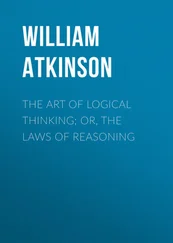It will be seen that the above Syllogism, whether expressed in words or symbols, is logically valid, because the conclusion must logically follow the premises. And, in this case, the premises being true, it must follow that the conclusion is true. Whately says: "A Syllogism is said to be valid when the conclusion logically follows from the premises; if the conclusion does not so follow, the Syllogism is invalid and constitutes a Fallacy, if the error deceives the reasoner himself; but if it is advanced with the idea of deceiving others it constitutes a Sophism."
The reason for Rule I is that only three propositions—a Major Premise, a Minor Premise, and a Conclusion—are needed to form a Syllogism. If we have more than three propositions, then we must have more than two premises from which to draw one conclusion. The presence of more than two premises would result in the formation of two or more Syllogisms, or else in the failure to form a Syllogism.
II. That there should be three and no more than three Terms. These Terms are (1) The Predicate of the Conclusion; (2) the Subject of the Conclusion; and (3) the Middle Term which must occur in both premises, being the connecting link in bringing the two other Terms together in the Conclusion.
The Predicate of the Conclusion is called the Major Term, because it is the greatest in extension compared with its fellow terms. The Subject of the Conclusion is called the Minor Term because it is the smallest in extension compared with its fellow terms. The Major and Minor Terms are called the Extremes . The Middle Term operates between the two Extremes.
The Major Term and the Middle Term must appear in the Major Premise .
The Minor Term and the Middle Term must appear in the Minor Premise .
The Minor Term and the Major Term must appear in the Conclusion .
Thus we see that The Major Term must be the Predicate of the Conclusion; the Minor Term the Subject of the Conclusion; the Middle Term may be the Subject or Predicate of either of the premises , but must always be found once in both premises .
The following example will show this arrangement more clearly:
In the Syllogism: "Man is mortal; Socrates is a man; therefore Socrates is mortal," we have the following arrangement: "Mortal," the Major Term; "Socrates," the Minor Term; and "Man," the Middle Term; as follows:
Major Premise : "Man" ( middle term ) is mortal ( major term ).
Minor Premise : "Socrates" ( minor term ) is a man ( major term ).
Conclusion : "Socrates" ( minor term ) is mortal ( major term ).
The reason for the rule that there shall be " only three " terms is that reasoning consists in comparing two terms with each other through the medium of a third term . There must be three terms; if there are more than three terms, we form two syllogisms instead of one.
III. That one premise, at least, must be affirmative. This, because "from two negative propositions nothing can be inferred." A negative proposition asserts that two things differ, and if we have two propositions so asserting difference, we can infer nothing from them. If our Syllogism stated that: (1) "Man is not mortal;" and (2) that "Socrates is not a man;" we could form no Conclusion, either that Socrates was or was not mortal. There would be no logical connection between the two premises, and therefore no Conclusion could be deduced therefrom. Therefore, at least one premise must be affirmative.
IV. If one premise is negative, the conclusion must be negative. This because "if one term agrees and another disagrees with a third term, they must disagree with each other." Thus if our Syllogism stated that: (1) "Man is not mortal;" and (2) that: "Socrates is a man;" we must announce the Negative Conclusion that: (3) "Socrates is not mortal."
V. That the Middle Term must be distributed; (that is, taken universally) in at least one premise. This "because, otherwise, the Major Term may be compared with one part of the Middle Term, and the Minor Term with another part of the latter; and there will be actually no common Middle Term, and consequently no common ground for an inference." The violation of this rule causes what is commonly known as "The Undistributed Middle," a celebrated Fallacy condemned by the logicians. In the Syllogism mentioned as an example in this chapter, the proposition " Man is mortal," really means " All men," that is, Man in his universal sense. Literally the proposition is "All men are mortal," from which it is seen that Socrates being " a man" (or some of all men) must partake of the quality of the universal Man. If the Syllogism, instead, read: " Some men are mortal," it would not follow that Socrates must be mortal—he might or might not be so. Another form of this fallacy is shown in the statement that (1) White is a color; (2) Black is a color; hence (3) Black must be White. The two premises really mean "White is some color; Black is some color;" and not that either is " all colors." Another example is: "Men are bipeds; birds are bipeds; hence, men are birds." In this example "bipeds" is not distributed as " all bipeds" but is simply not-distributed as " some bipeds." These syllogisms, therefore, not being according to rule, must fail. They are not true syllogisms, and constitute fallacies.
To be " distributed ," the Middle Term must be the Subject of a Universal Proposition, or the Predicate of a Negative Proposition; to be " undistributed " it must be the Subject of a Particular Proposition, or the Predicate of an Affirmative Proposition. (See chapter on Propositions.)
VI. That an extreme, if undistributed in a Premise, may not be distributed in the Conclusion. This because it would be illogical and unreasonable to assert more in the conclusion than we find in the premises. It would be most illogical to argue that: (1) "All horses are animals; (2) no man is a horse; therefore (3) no man is an animal." The conclusion would be invalid, because the term animal is distributed in the conclusion, (being the predicate of a negative proposition) while it is not distributed in the premise (being the predicate of an affirmative proposition).
As we have said before, any Syllogism which violates any of the above six syllogisms is invalid and a fallacy.
There are two additional rules which may be called derivative. Any syllogism which violates either of these two derivative rules, also violates one or more of the first six rules as given above in detail.
The Two Derivative Rules of the Syllogism are as follows:
VII. That one Premise at least must be Universal. This because "from two particular premises no conclusion can be drawn."
VIII. That if one premise is Particular, the Conclusion must be particular also. This because only a universal conclusion can be drawn from two universal premises.
The principles involved in these two Derivative Rules may be tested by stating Syllogisms violating them. They contain the essence of the other rules, and every syllogism which breaks them will be found to also break one or more of the other rules given.
CHAPTER XVII.
VARIETIES OF SYLLOGISMS
Table of Content
The authorities in Logic hold that with the four kinds of propositions grouped in every possible order of arrangement, it is possible to form nineteen different kinds of valid arguments, which are called the nineteen moods of the syllogism . These are classified by division into what are called the four figures , each of which figures may be known by the position of the middle term in the premises. Logicians have arranged elaborate and curious tables constructed to show what kinds of propositions when joined in a particular order of arrangement will make sound and valid syllogisms. We shall not set forth these tables here, as they are too technical for a popular presentation of the subject before us, and because they are not necessary to the student who will thoroughly familiarize himself with the above stated Laws of the Syllogism and who will therefore be able to determine in every case whether any given argument is a correct syllogism, or otherwise.
Читать дальше












